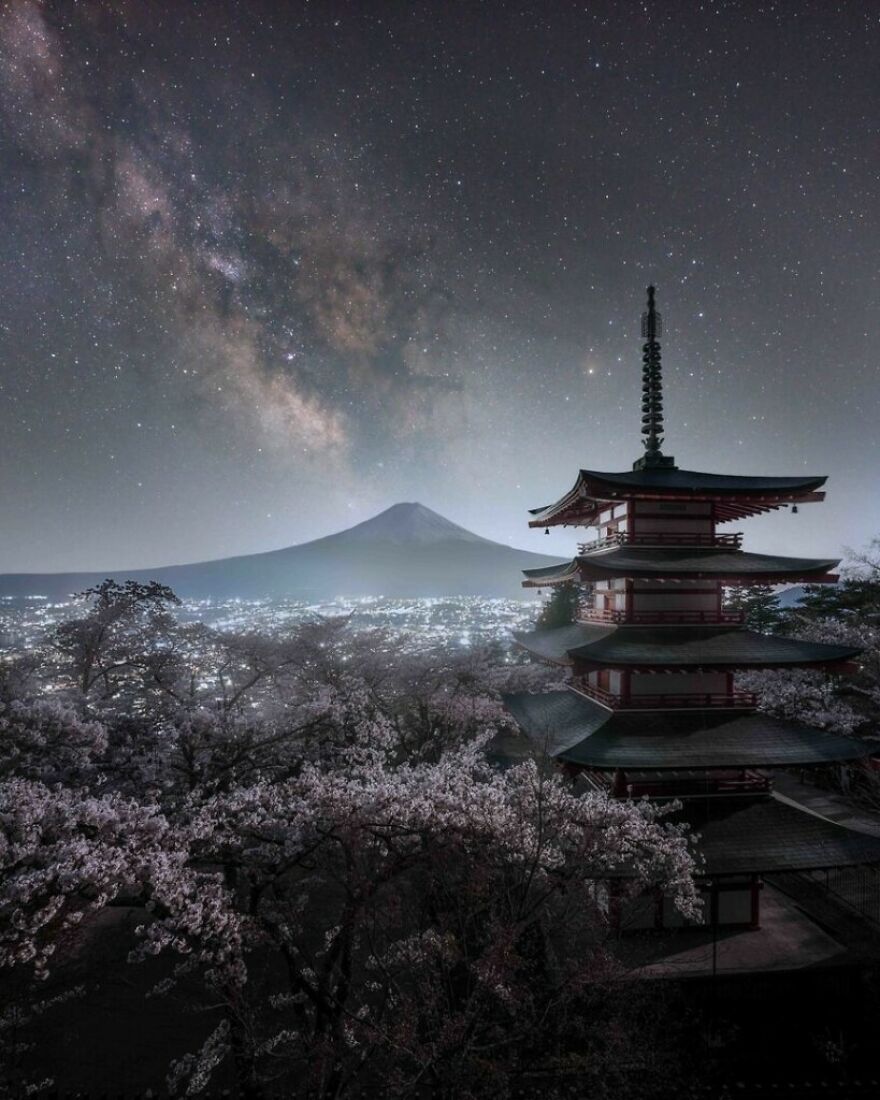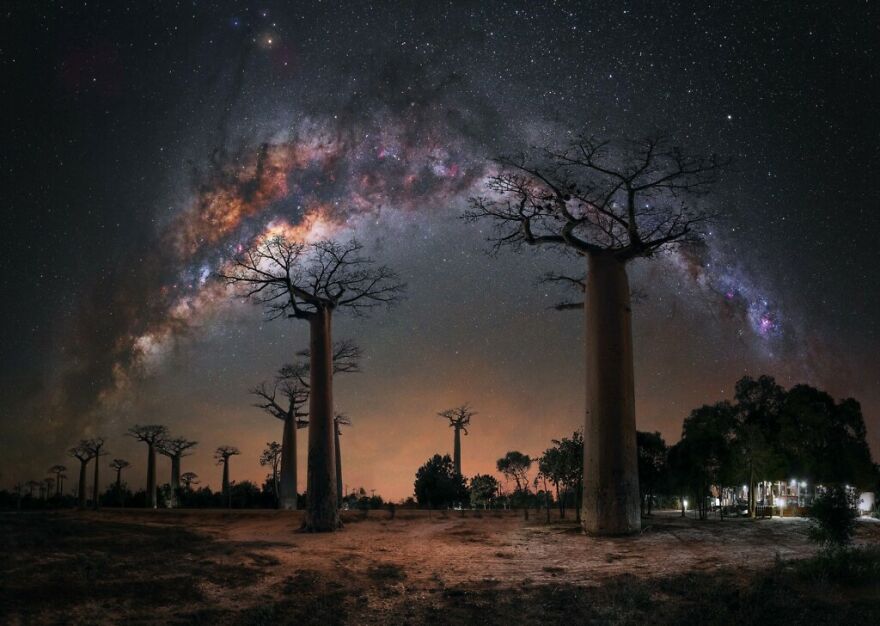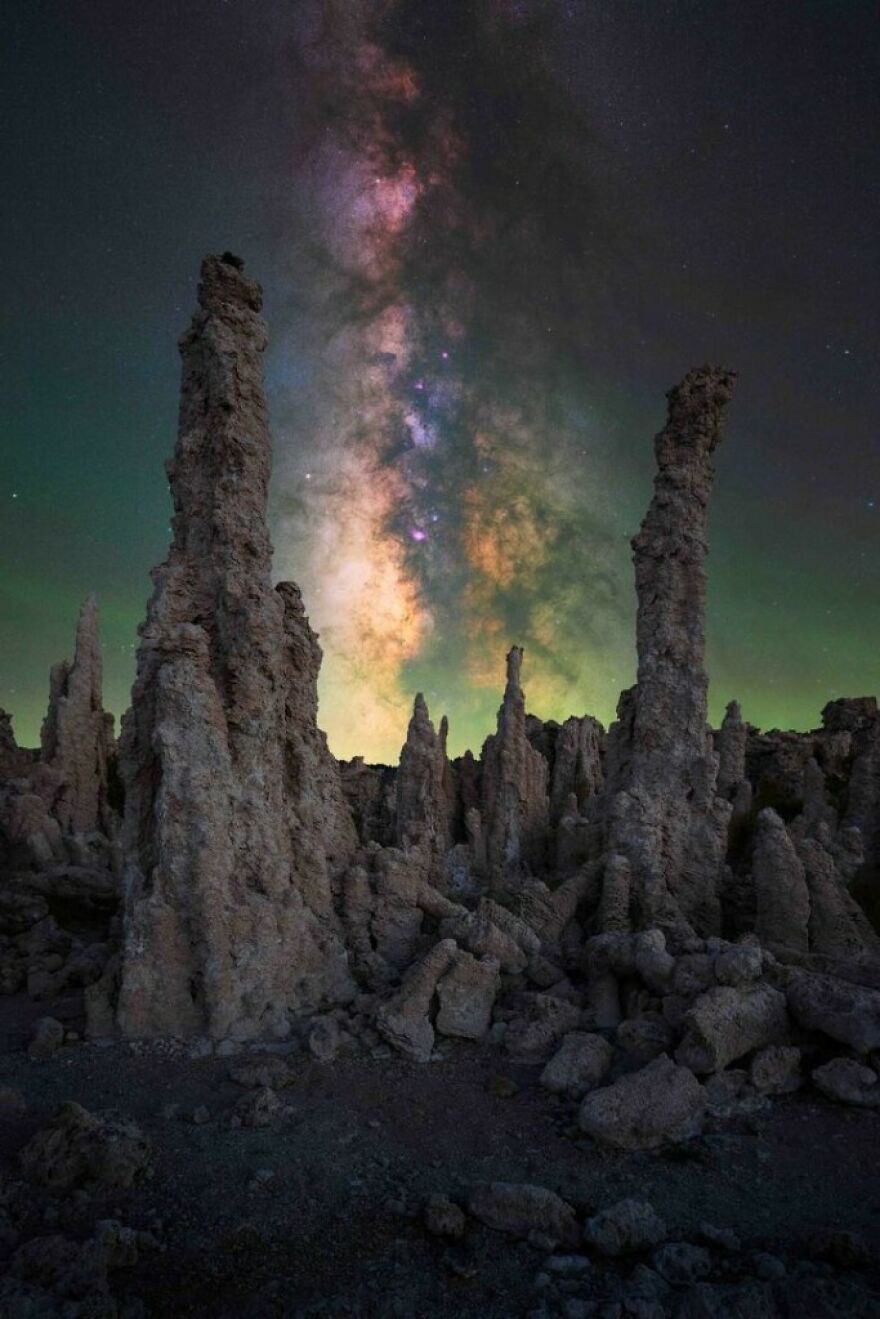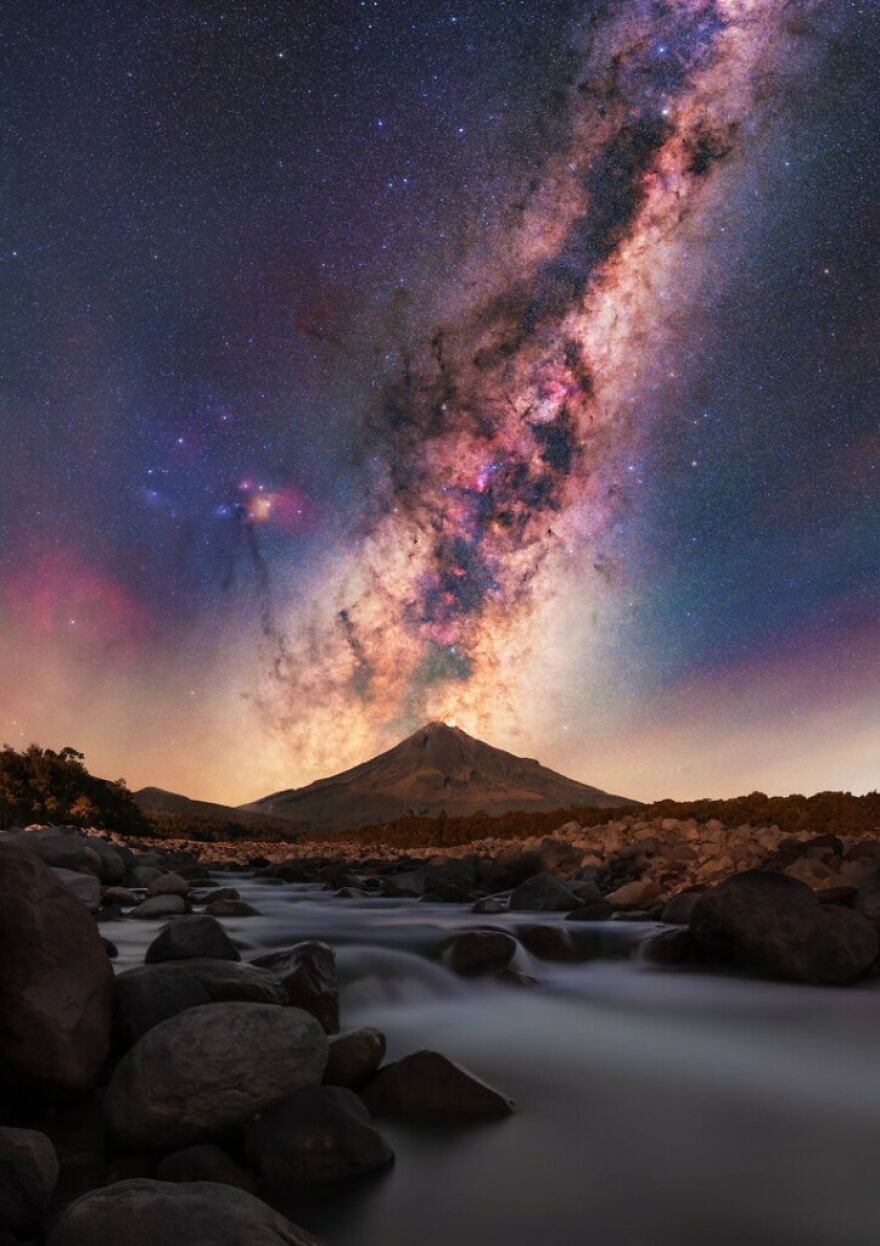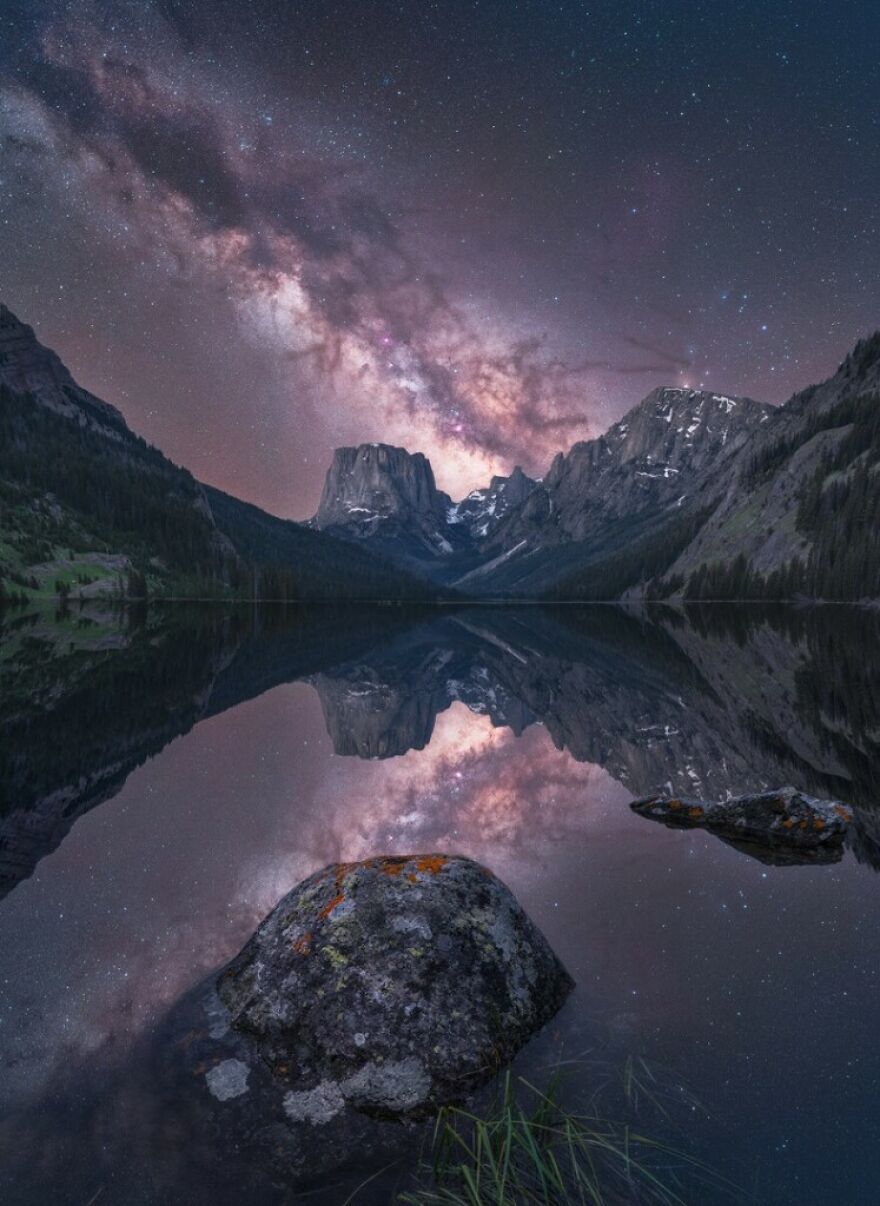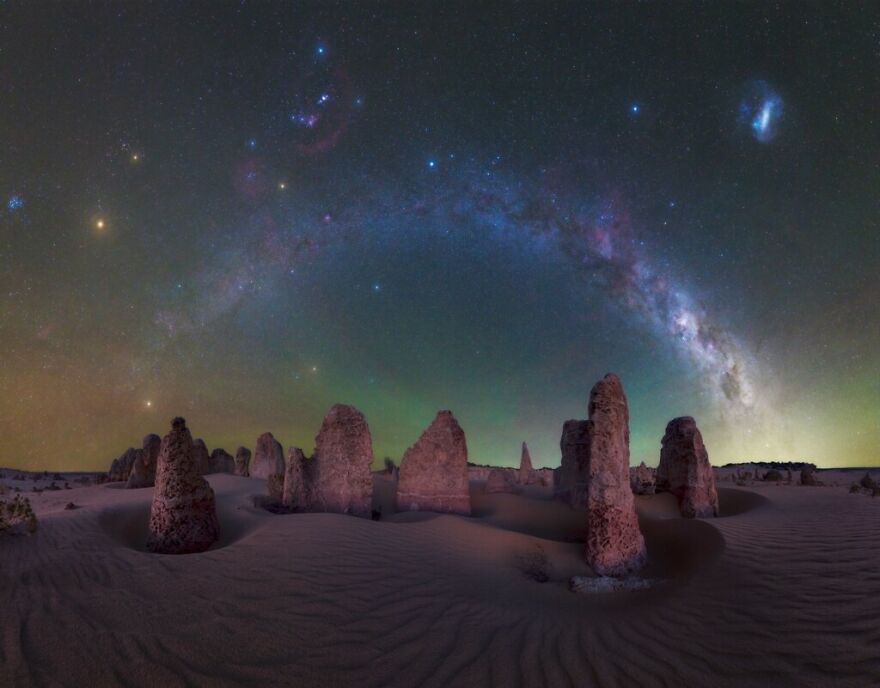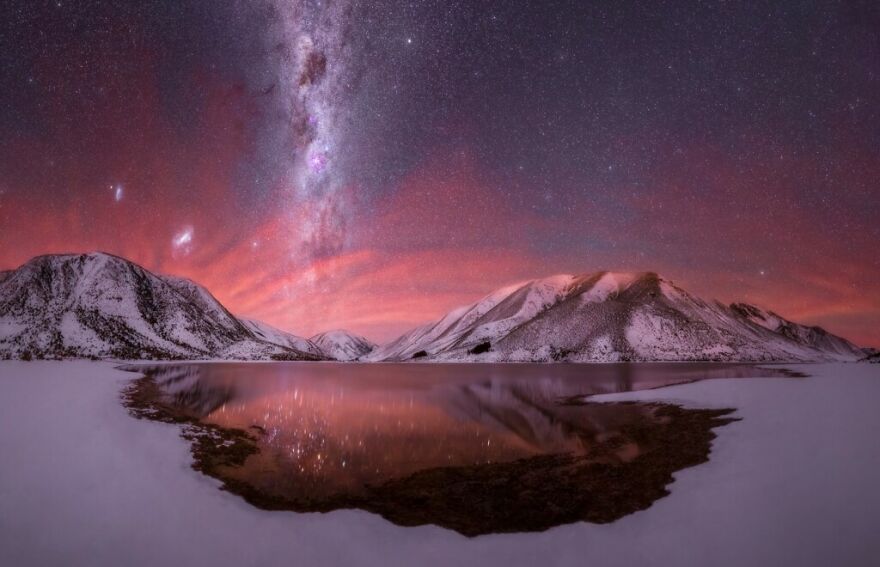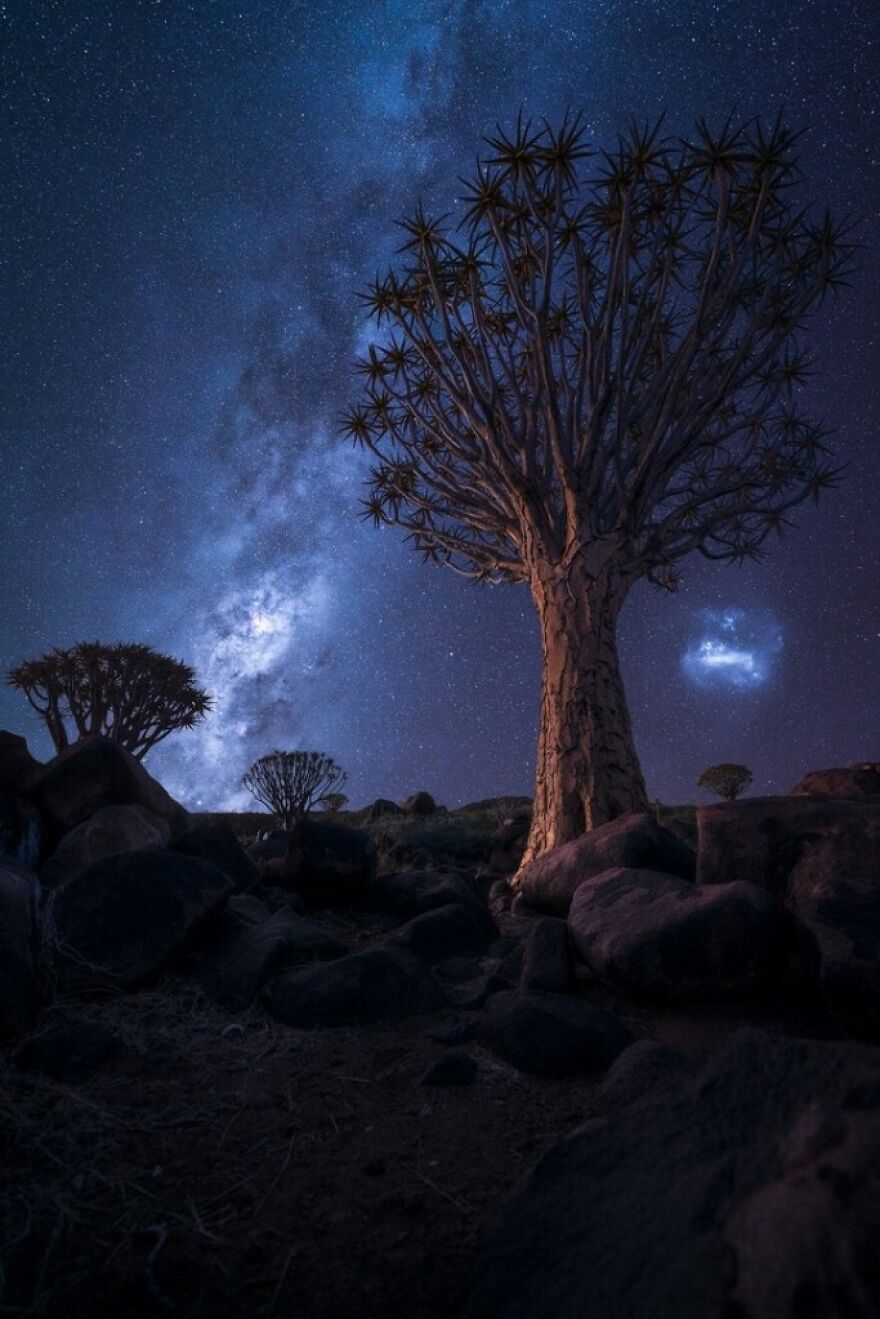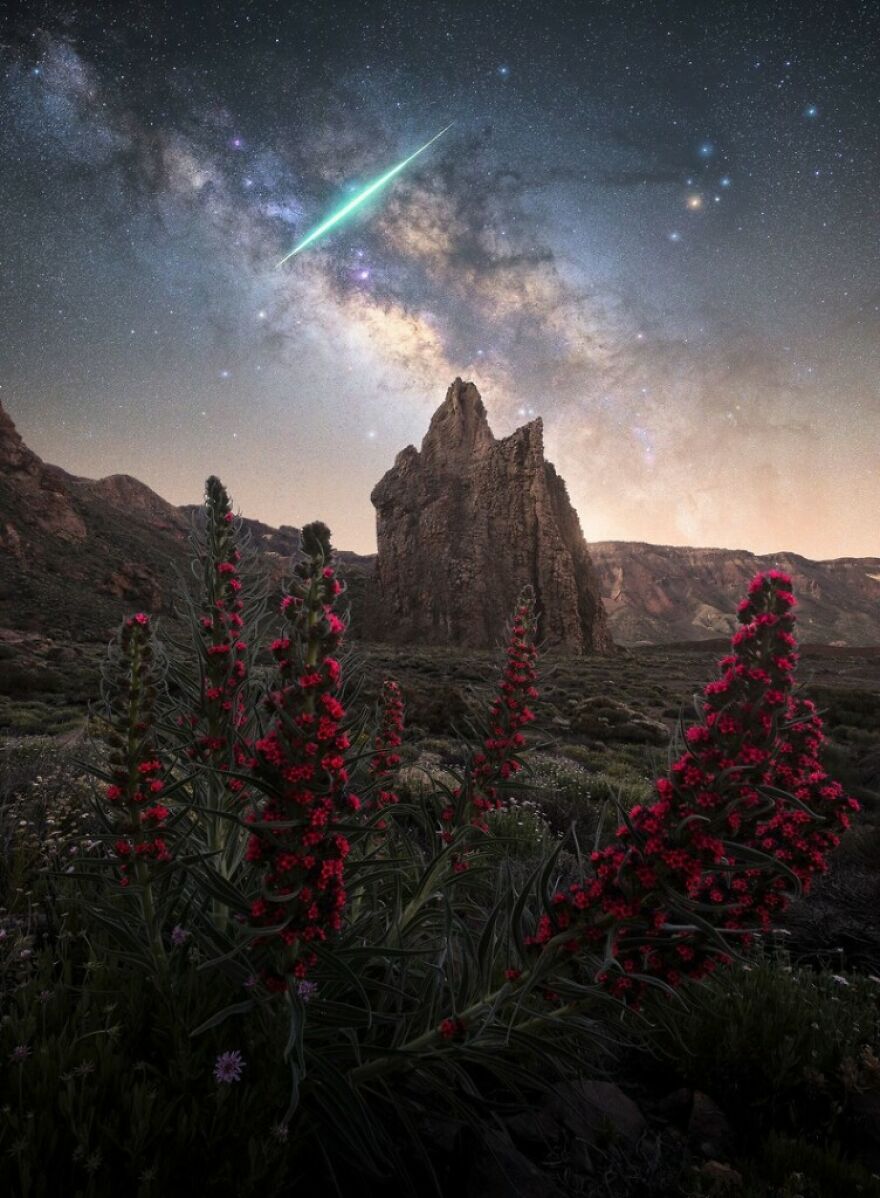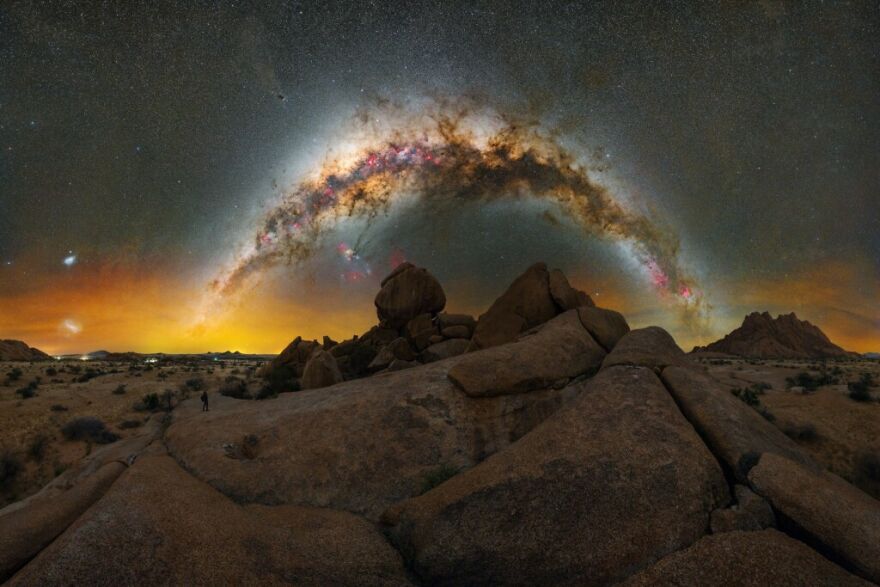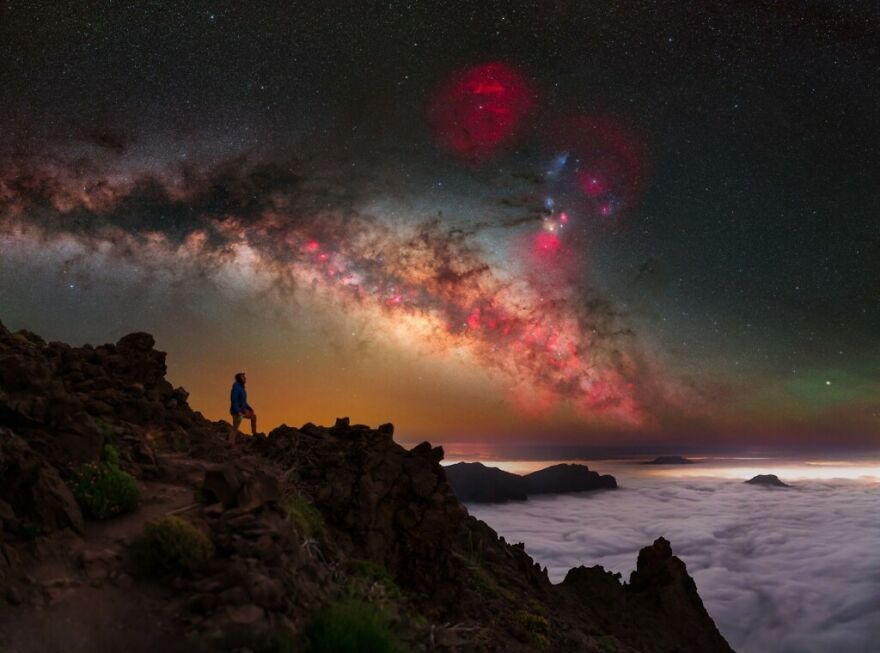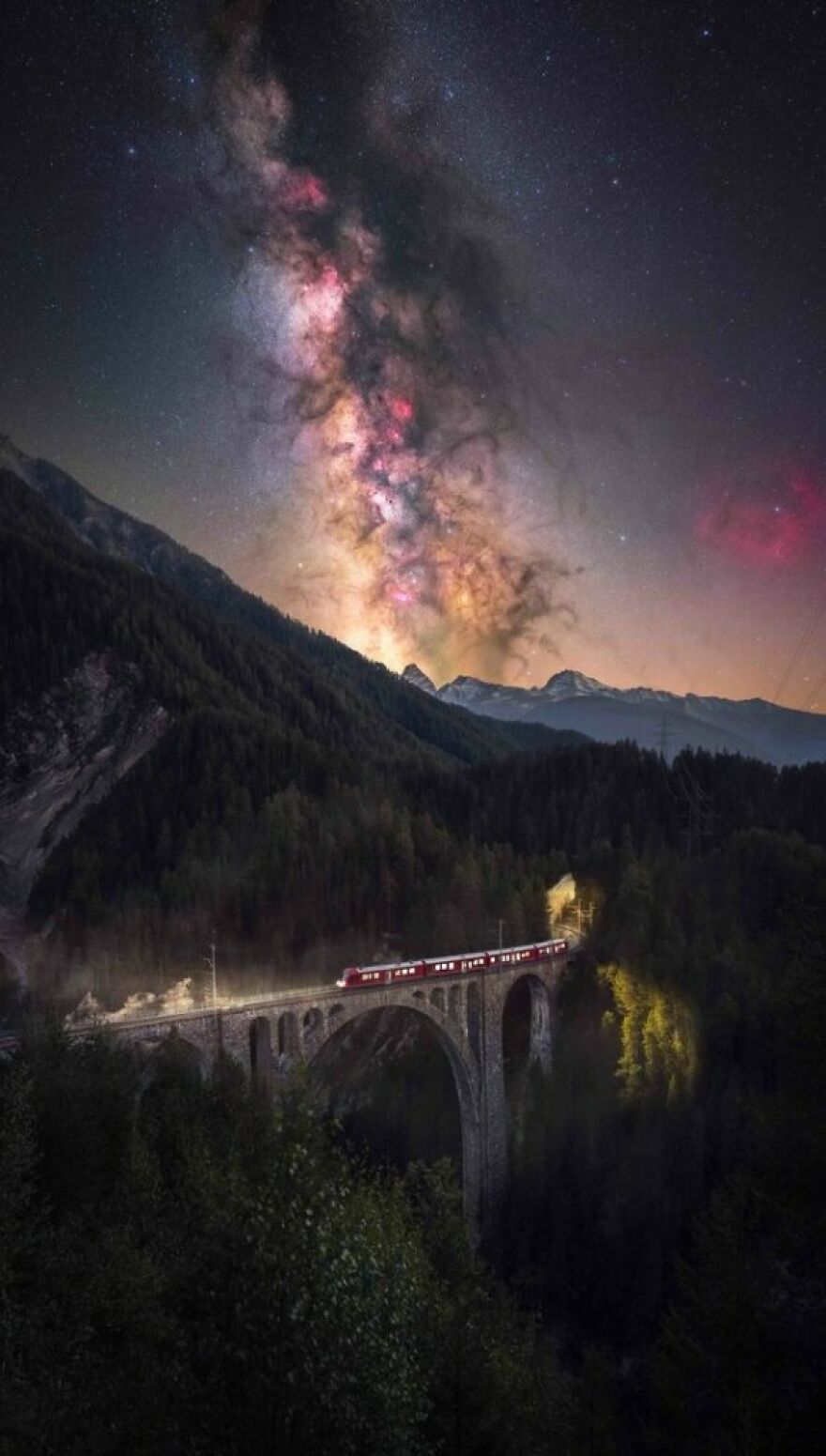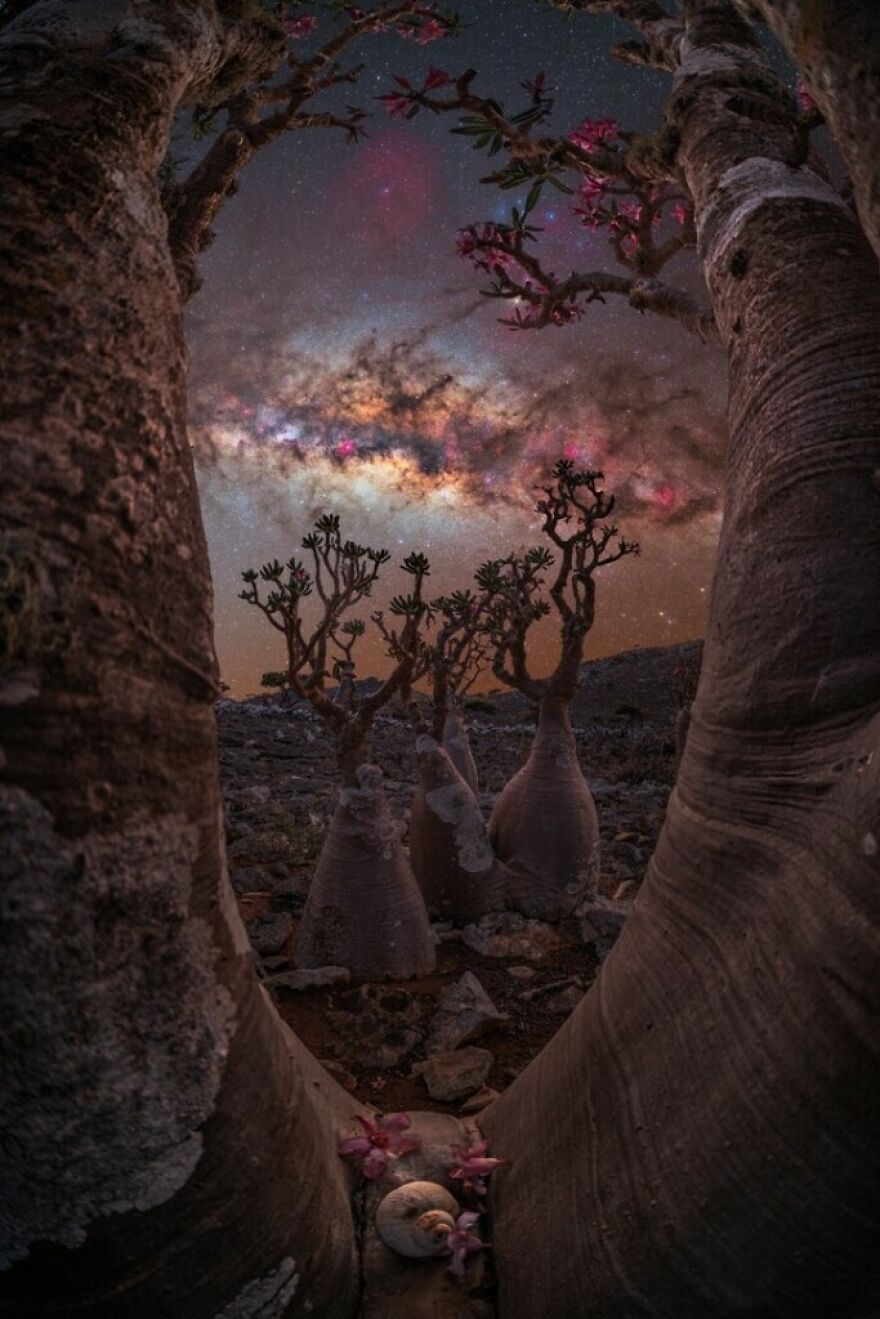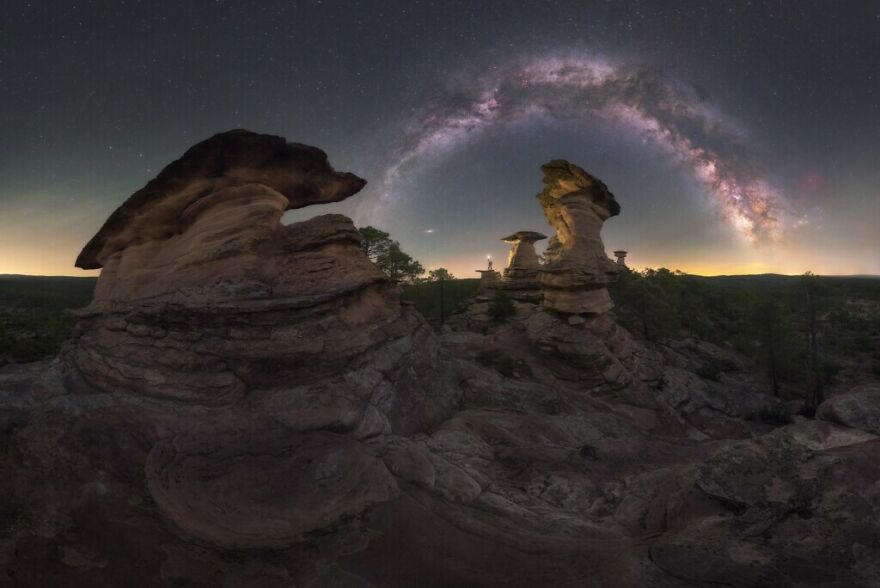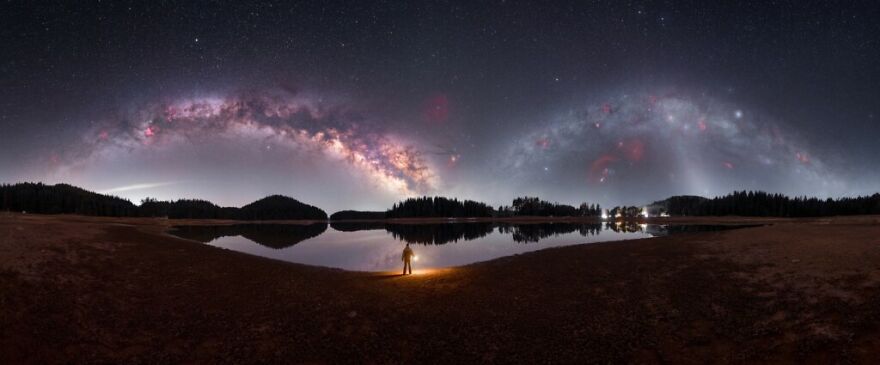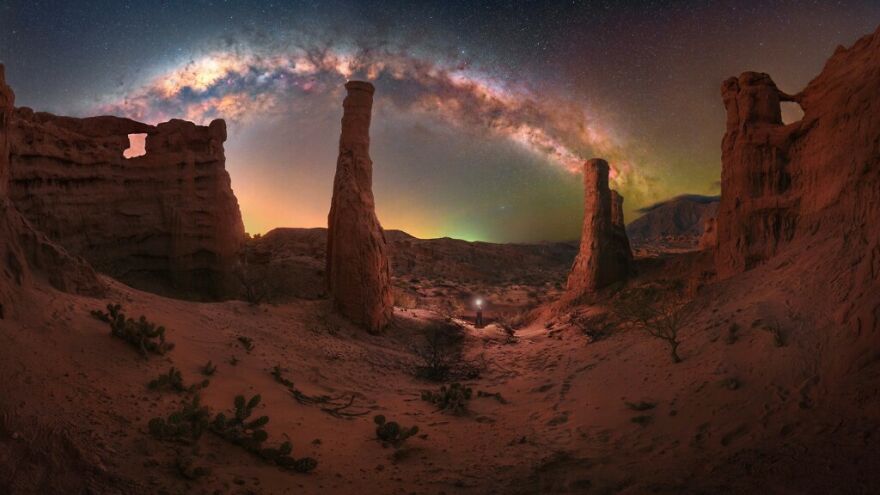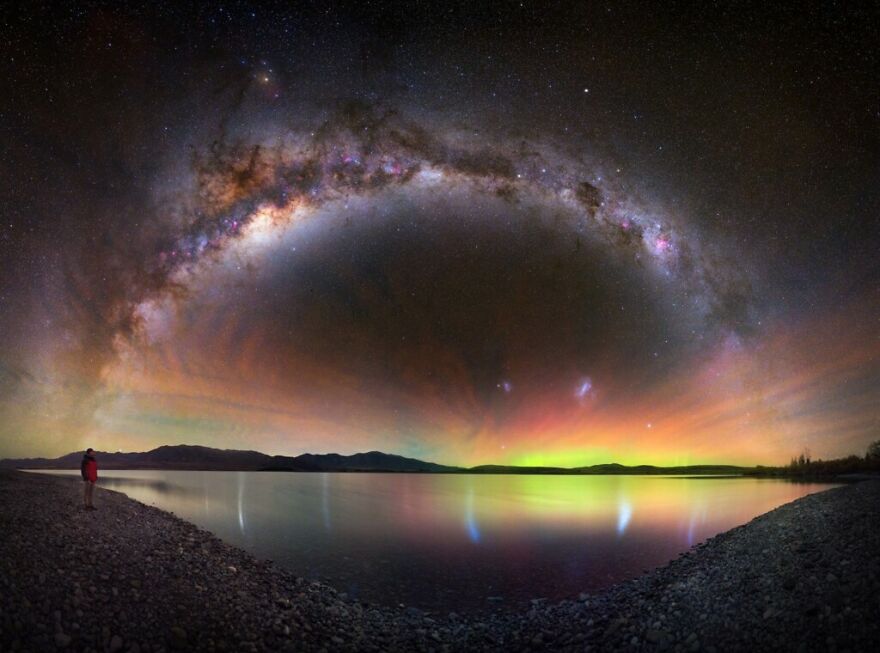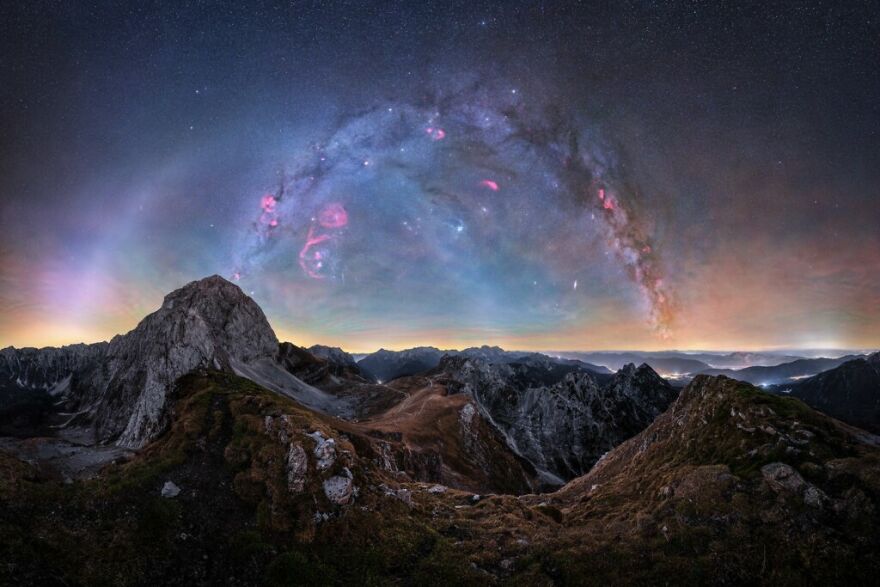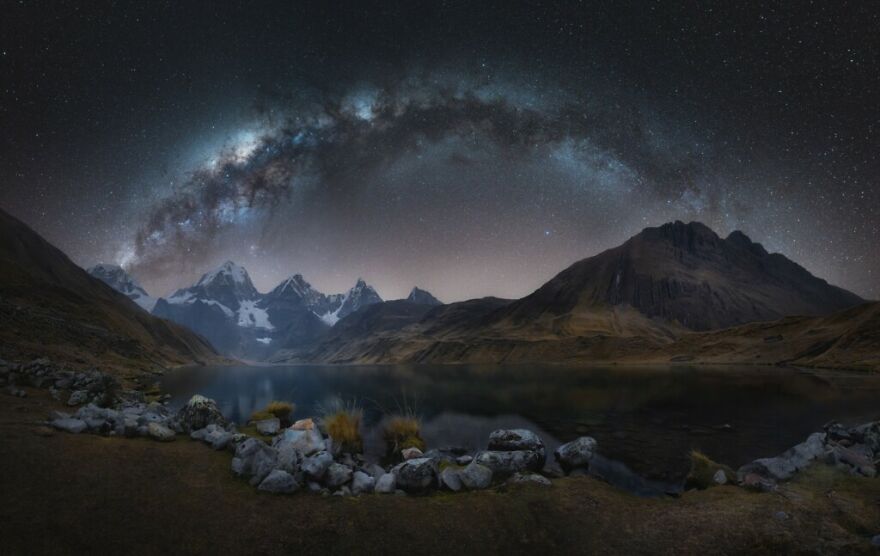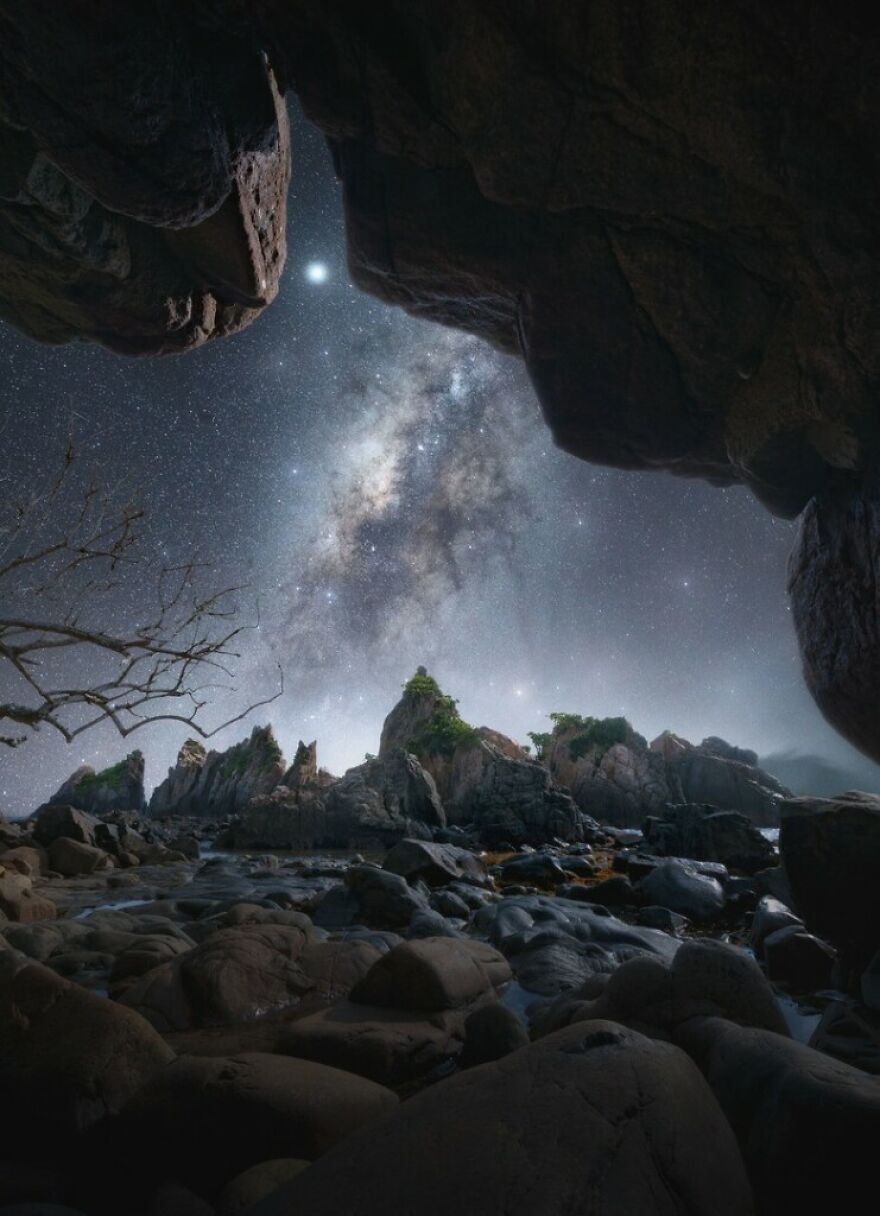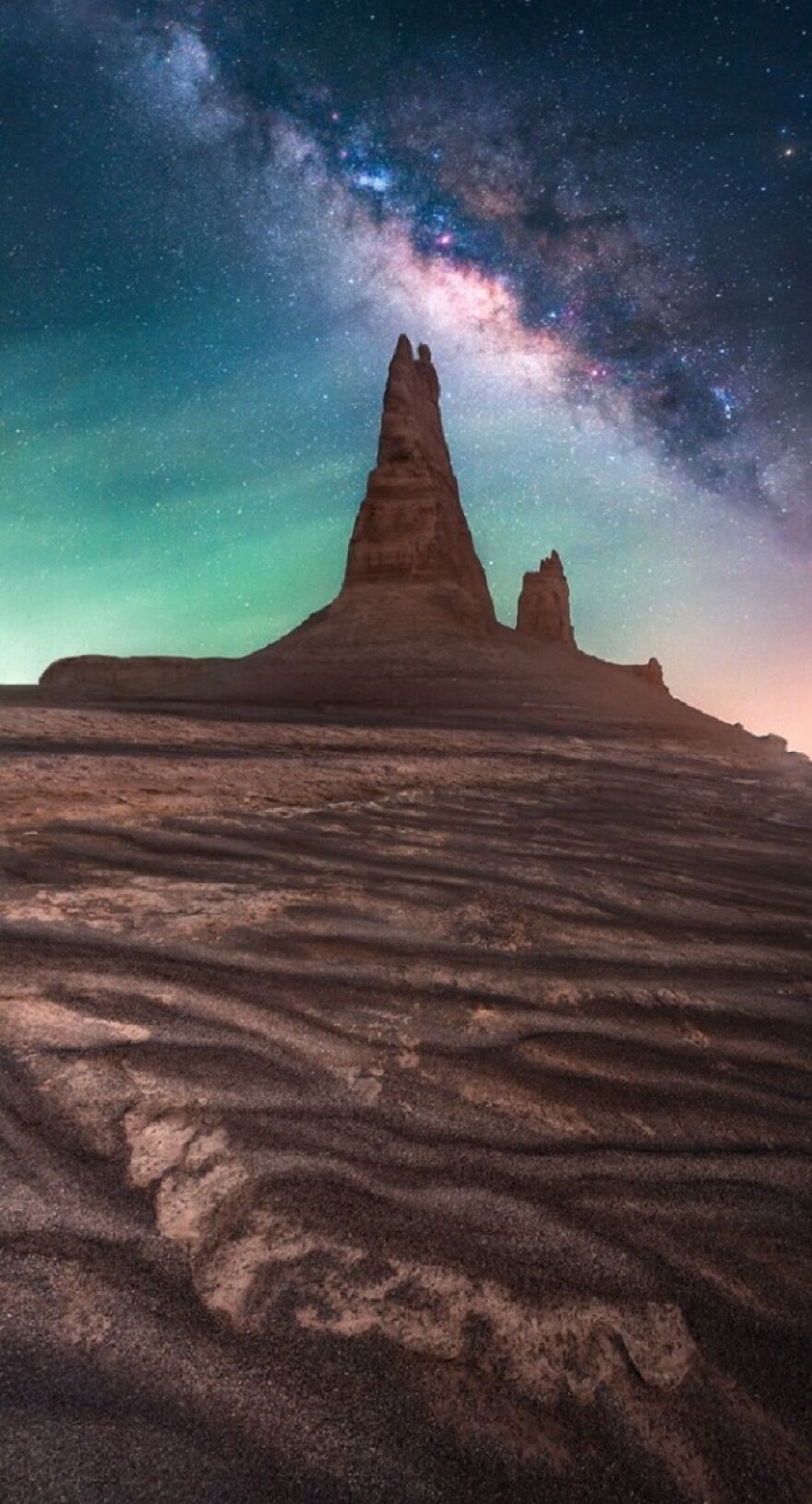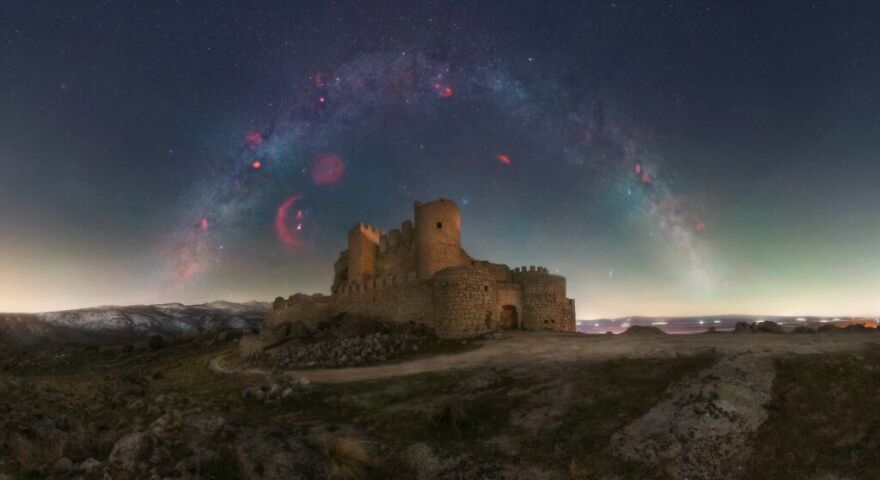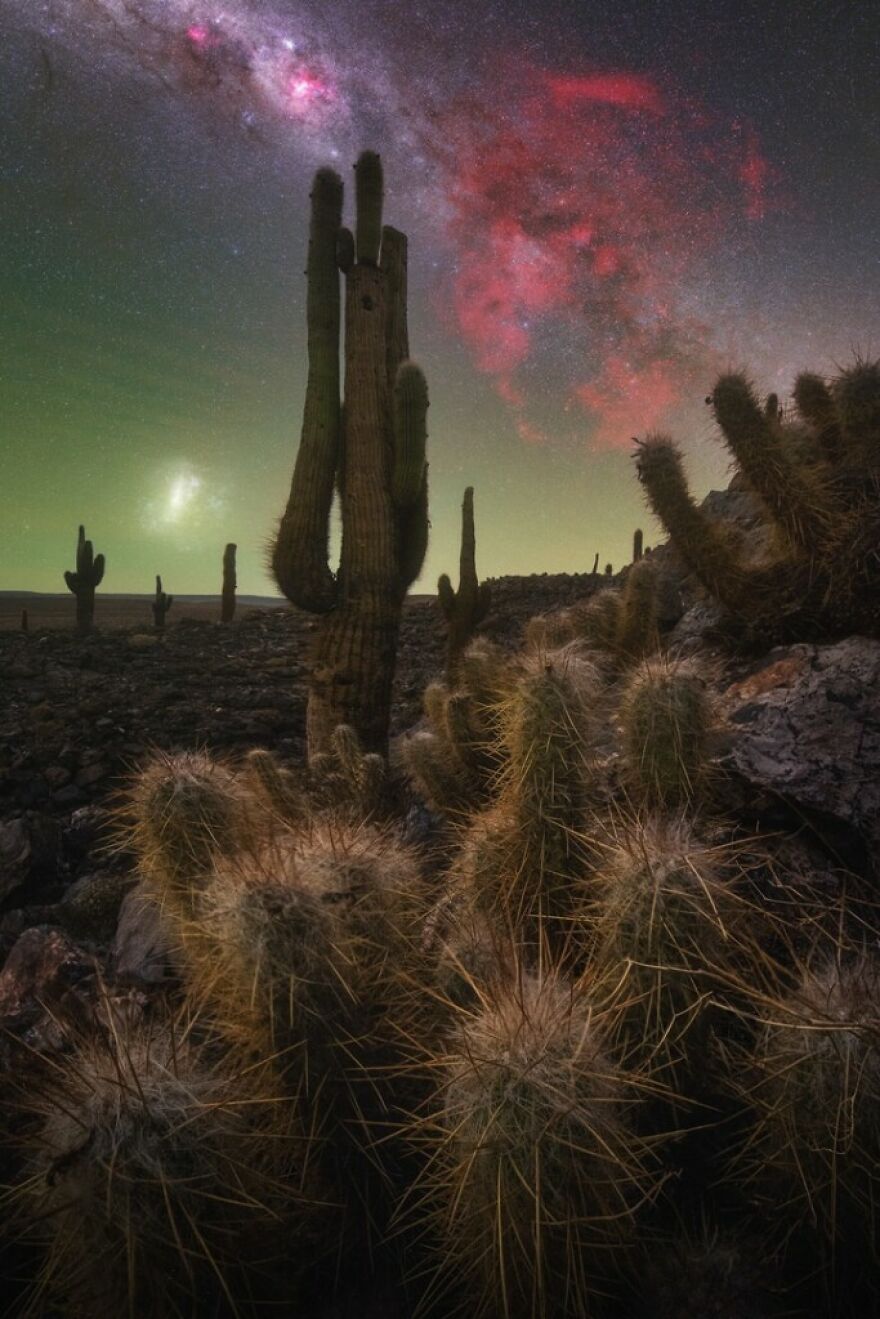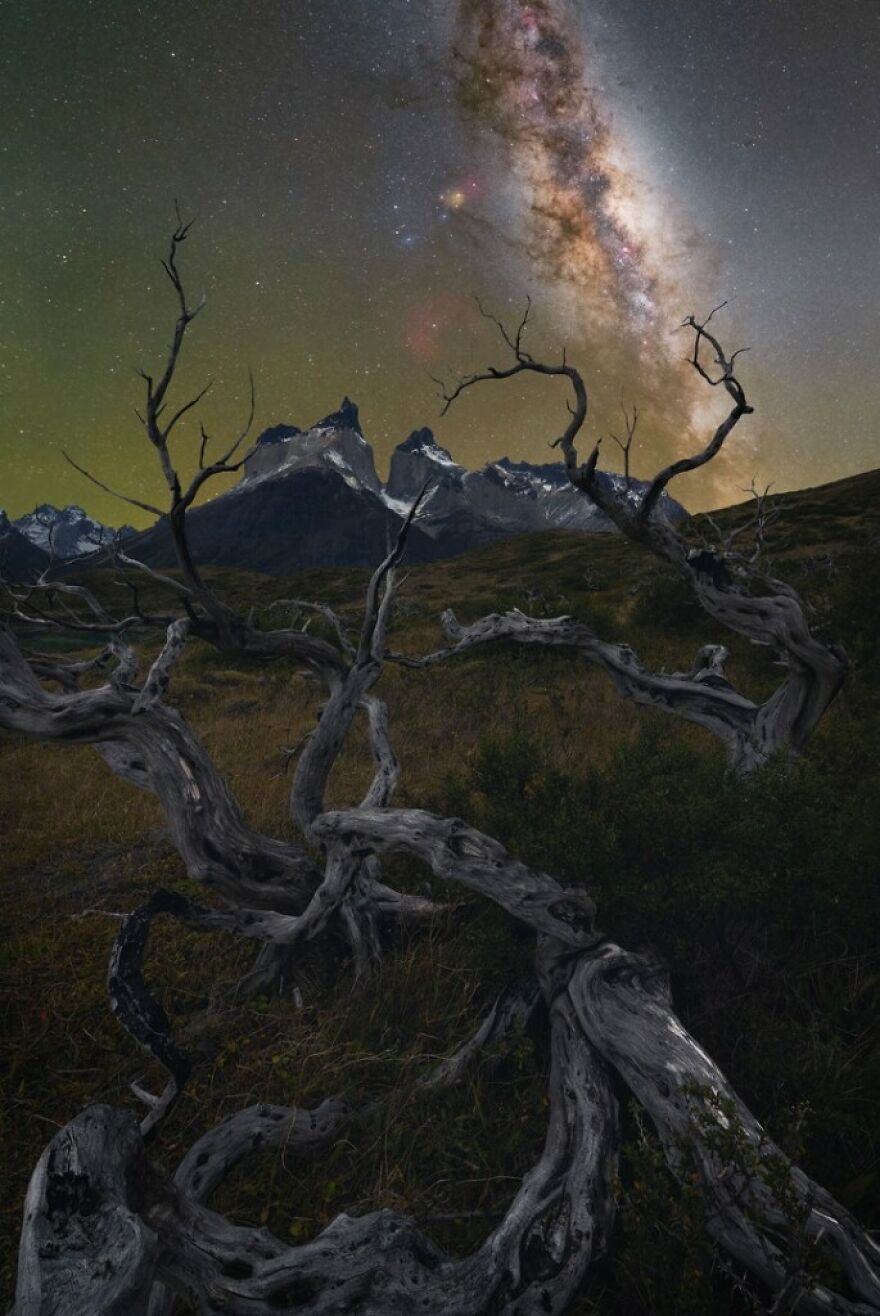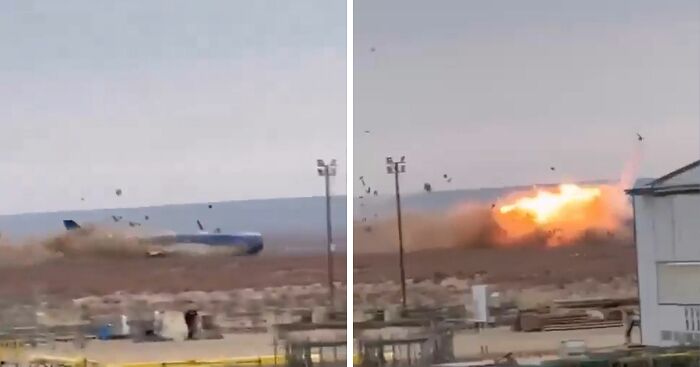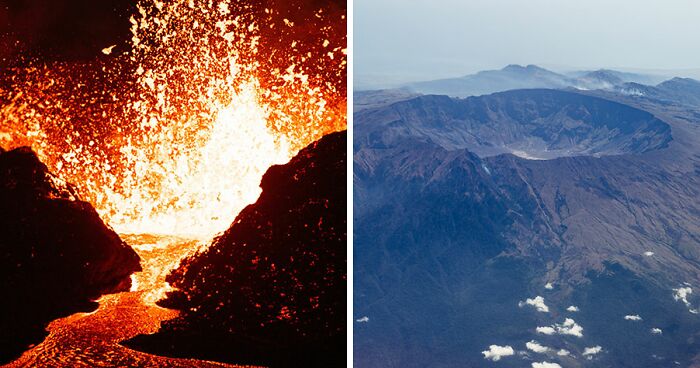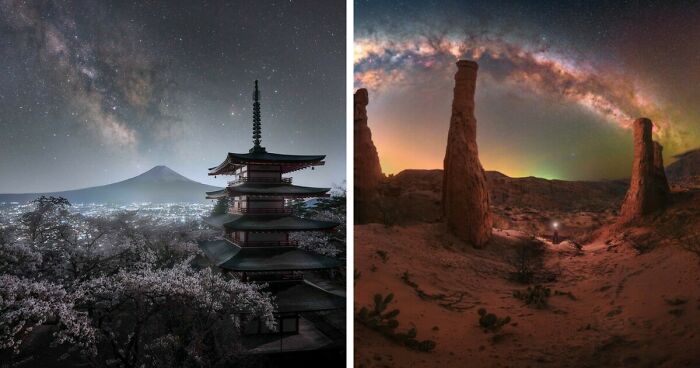
4Kviews
From Remote Deserts To Lost Landscapes: This Year’s 25 Winning Images Of The Milky Way Photographed Around The World
We can't solve all the mysteries of the cosmos, but we can appreciate its beauty and complexity. Luckily, Milky Way photography lets us gaze into the sky in all its glory. So today, we would like to share some of the most beautiful Milky Way photographs of 2023.
"Capture The Atlas" has announced the sixth edition of Milky Way Photographer of the Year competition winners, who captured the most beautiful sights around the globe in the night sky. This time you are going to see various places that range from the remote deserts of Socotra, Madagascar, Atacama, and Namibia to the lost landscapes of Patagonia, Australia, and New Zealand. So without further ado, we invite you to explore this astonishing collection, and if you would like to see previous posts of winners on Bored Panda, see here, here, and here.
More info: capturetheatlas.com | capturetheatlas.com | Instagram | Facebook | youtube.com
This post may include affiliate links.
“The Scenery I Wanted To See” – Mitsuhiro Okabe
Yamagashi Prefecture, Japan.
"Mount Fuji, Japan’s iconic symbol, dominates the backdrop of this image, set during cherry blossom season. Amidst the landscape, you can see a sacred temple dedicated to honoring the spirits of the departed. And there, against the dark canvas of the night sky, the ethereal beauty of the Milky Way came into view."
“Night Under The Baobab Trees” – Steffi Lieberman
Baobab Avenue, Madagascar.
"Astro landscape panorama from Madagascar. Here you see the complete Milky Way arc over the imposing baobabs.
This photo means a lot to me, and I can’t even begin to tell you how difficult it was to take it. From the road conditions to the armed security guards protecting you while you take photos, everything about it was an adventure."
“Alien Forest” – Marcin Zając
Mono Lake, California.
"These strange, cream-colored rock towers located near Mono Lake are called tufas. They formed when underwater springs that are rich in calcium mixed with the waters of the lake, which are rich in carbonates. The resulting reaction formed limestone. Over time, the buildup of limestone formed towers, and when the lake’s water level dropped, the towers became exposed."
“Milky Way Rising Over Stony River & Mt Taranaki” – Brendan Larsen
Taranaki, New Zealand.
"Getting the Milky Way lined up over Mount Taranaki in New Zealand from this location in early March meant a late night as it didn’t line up until 2:30 in the morning in the morning, but I was keen to make the most of the perfectly clear skies on that night.
I’m really pleased with how many colors I was able to capture with my camera, filters, and long exposures. Rho Ophiuchi in Scorpius looks really good with its pink, yellow, and blue colors, along with the Zeta Ophiuchi Nebula (the pinkish nebula to the lower left of the image came out well too). On the lower right of the image, there’s some nice airglow, which adds to the beauty and uniqueness of the sky that night."
“Wind River Nights” – Brandt Ryder
Wind River, USA.
"The Wind River Range, unlike the Tetons, is one of the hidden gems of Wyoming. This location had captured my imagination for years, but I tended to shy away from it because it is notorious for having some of the worst mosquitoes in the world. Regardless of this, this past June I finally made the trek, and the trip was one I’ll remember for a lifetime, bugs and all.
This image was taken at a sheltered lake deep in the wilderness where the reflections were so pristine that it’s nearly impossible to separate the sky from the earth. Memories like this hold an extra special place in my heart as I was able to share this spectacular spot with my 7-year-old.
I can still hear her words ringing in my ears “Daddy this must be the most beautiful place on earth”. Yes, little one, it is, it is."
“Interstellar” – Jose Luis Cantabrana Garcia
Pinnacles Desert, WA, Australia.
"I had dreamed of visiting this location ever since I saw the breathtaking images captured by Michael Goh, also known as “Astrophotobear,” whose work has also been featured as part of this contest in previous years.
‘Interstellar’ captures not only the epic beauty of this desert location and the night sky, but also the personal sense of wonder and accomplishment that comes from checking off a long-awaited destination from my list.
This area is sacred to the Noongar people, the traditional owners of this land, and in the past, it was only accessible to women. The story goes that these limestone rocks are nothing but petrified ghosts of the men who dared to enter and were then eternally punished by the gods.
These timeless guardians stand tall and proud, reaching toward the starry sky above. As the summer Milky Way stretches across the night sky, these ancient ghosts seem to bridge the earthly world with the interstellar realm beyond."
“Winter’s Airglow” – Larryn Rae
Southern Alps, New Zealand.
"This was some of the craziest airglow I have ever seen! Airglow is when atoms get charged and excited in the upper atmosphere by the sun and emit this wonderful color and cloud-like pattern.
This image happened by pure accident while I was waiting for a friend to arrive at another location. I thought while waiting that I would take some shots at this lake on the way, and as soon as I had the first image on the screen, I knew I was about to capture something pretty amazing! An hour later, after scouting a good composition, I had my panorama in the bag. This is a testament to expecting the unexpected and to always taking a shot, even when it’s not your planned destination!"
“Quiver Dreams” – Peter Hoszang
Keetmanshoop, Namibia.
"This is an image I’ve been looking forward to capturing for so long. I’m happy to finally be able to share a photo displaying the magical quiver trees along with the pristine Namibian night sky.
The quiver tree, or kokerboom, is a tall, branching species of succulent plant indigenous to Southern Africa, specifically the Northern Cape province of South Africa and parts of Southern Namibia. One of the few forests of kokerboom is the Quiver Tree Forest, close to Keetmanshoop in Namibia.
In the sky, on the left side, you can see part of the Milky Way galaxy and the Large Magellanic Cloud, a relatively small, irregular galaxy in the neighborhood of the Milky Way (on the right)."
“The Cathedral Light Show” – Roksolyana Hilevych
Tenerife, Spain.
"Sometimes it takes a bit of luck. This was definitely the best moment I’ve ever had during a nighttime session; this only happens once in a lifetime. However, I really hope to be able to see the fireball again someday!
It was the first and only time I saw such a bright meteor. It lit up everything around it, making it seem like daytime for a few seconds. Luckily, at the moment it appeared, I was photographing the core of the Milky Way.
Right after I finished capturing the Milky Way with a star tracker, I took a close-up shot of the tajinastes in full bloom. The photo also includes this particular mountain in the background that resembles a cathedral."
“South Of Home” – Lorenzo Ranieri Tenti
Namibia, Africa.
"My journey to Namibia, particularly the Erongo area, was an extraordinary adventure, immersing me in the captivating beauty of the southern night sky. The panoramic photograph captures the breathtaking scene in the Gross Spitzkoppe Nature Reserve, where the southern Milky Way gracefully spans a remarkable formation of smooth granite boulders. This area holds a unique charm, with Mount Spitzkoppe being the sole prominent feature for kilometers, majestically rising 700 meters above the endless savannah.
As I explored the surrounding savannah, far from my tent and trusty 4×4 that served as my home during this adventure, I stumbled upon this spectacular rock formation. Instantly, a composition formed in my mind, as I knew that the Milky Way would cross this landscape that night. Excitement consumed me as I prepared for the shot, eagerly awaiting the moon’s descent.
In the midst of emotion and adrenaline, typical of such starry nights, I began capturing the scene. As the long night drew to a close, I deeply appreciated the precious gift bestowed upon me by the African night, a world away from my home."
wow!! you know the animals that are up at night probably wait for that too.
“The La Palma Astroexperience” – Jakob Sahner
La Palma, Spain.
"La Palma and the Canary Islands are ideal for astrophotography due to the trade wind clouds that sit at around 1000 meters. Being above these clouds makes it clear enough for capturing images, provided there is no haze or high cirrus clouds.
On the first night of the trip, I was exhausted from a long journey and no sleep, but I couldn’t resist going out to capture the clear sky, as it was the first time I’ve experienced this much cloud cover. However, I would caution that exploring the terrain at night can be dangerous and should only be done by those familiar with it."
“The Night Train” – Alexander Forst
Graubünden, Switzerland.
"I photographed the night train last September at the Wiesener Viaduct. This photo is from a series of bridge photos that I started two years ago.
Stopping movement is a common thing in photography. It is not as common in night photography, where movements become long, abstract lines due to the long exposure time. Two years ago I started experimenting with the stillness of moving objects in night photography and came up with a technique to make that possible. I photographed the train during the blue hour and the lights of the train at night.
When photographing complex projects like this, order is very important. After setting up the equipment and finding the right perspective, the first thing I had to do was photograph the train; then, when night fell, the foreground and the lights of the last train; and finally, the Milky Way. I then put the pictures in Photoshop overlaid with the rest of the foreground and Milky Way shots."
“The Bottle Tree Portal” – Benjamin Barakat
Socotra, Yemen.
"I captured this image during my yearly photography expedition to Socotra.
Nights on the mystical island of Socotra are unforgettable, especially under the embrace of the most alien-looking and beautiful trees I have ever seen. Their gnarled and twisted trunks seemed to tell stories of ancient times while the blooming pink flowers added a touch of ethereal beauty.
However, what truly took my breath away was the darkness. It was as if someone had flipped a switch and turned off all the lights in the world. The stars shone so brightly that it felt like I could touch them. The horizon was so dark that it looked like the zenith.
In that moment, I felt small and insignificant, but incredibly alive, connected to the primal forces of nature that shaped this magical place over millions of years."
“Milky Way Over Cuenca’s Hoodoos” – Luis Cajete
Cuenca, Spain.
"One of my passions is capturing large panoramas through night photography. Living in a big city, I have always battled against intense light pollution. That’s why I’ve spent years searching for places where I can truly appreciate the beauty of the stars. Witnessing the arc of the Milky Way is an absolutely awe-inspiring experience.
Some of Spain’s darkest skies can be found in the Serrania de Cuenca, an area of remarkable geological beauty. In the southern region lies a place where water has carved the landscape, creating intriguing formations and limestone chimneys.
I scouted for a pleasing composition during the day, and this is the result of a long night spent under millions of stars. I hope you enjoy it."
“The Eyes Of The Universe” – Mihail Minkov
Bulgaria.
"I’ve always wondered what the night sky would look like if we could see the two Milky Way arches from the winter and summer side by side. This is practically impossible since they are part of a whole and are visible at different times of the day.
However, this 360-degree time-blended panorama shows us what they would look like. The two arches of the Milky Way represent one object in the starry sky, with part of it visible in winter and part of it in summer. Therefore, they are called the winter and summer arches. The winter arch includes objects that we can observe from October to March, primarily associated with the constellation Orion.
On the other hand, the summer arch features the Milky Way core, visible from March to September, which is the most characteristic and luminous part of the night sky, representing the center of our galaxy."
“Cafayate Star Factory” – Gonzalo Santile
Cafayate Salta, Argentina.
"To capture this shot, I arrived before the blue hour and as soon as the first stars appeared, with some light still shining on the landscape, I took the images for the foreground. After that, when it was completely dark, I shot the vertical photos of the sky.
As the Milky Way was already very low at that time of the year I had to hurry as I only had one chance to get the images of the sky once it got dark. I aligned my tracker and the action began.
In the image, you can see the rock formations and “windows” of this area of Cafayate Desert known as Las Ventanas (“The Windows”) and the small cacti that are the only vegetation here. I was able to capture the reddish colors of the nebulae and more details in the night sky thanks to the combination of a star tracker and an astro-modified camera."
“Celestial Radiance” – Tom Rae
Lake Tekapo, New Zealand.
"Photographing the night sky has been both awe-inspiring and frustrating. The sheer beauty, the exhilaration of capturing an image, and the tranquility all make it a unique experience. Under the night sky, a profound connection with nature and the universe develops, offering a new perspective on life and appreciation for the world.
As night fell, the autumn sky revealed itself, and I began shooting. Midway through my Milky Way panorama, a faint glow appeared on the horizon—my first aurora! What followed was a spectacular light show of flowing beams and vibrant colors.
The image also showcases airglow, a wave-like pattern of red and green caused by ionized molecules in our atmosphere. But the true focus remains the Milky Way galaxy gracefully spanning the sky, accompanied by the Magellanic Clouds, its smaller satellite galaxies, hovering above the aurora."
“Awakening Of Senses” – Violeta Lazareva
Socotra, Yemen.
"This picture was taken in one of the darkest places in the world: Socotra, a mystical island located in the Indian Ocean between Yemen’s mainland and Somalia.
The combination of endemic dragon blood trees with an outstanding Milky Way just blows your mind when you are standing there. The beauty of this place awakens all of your deepest senses. You immediately fall in love with this synergy of inner light and outer darkness. I wanted to capture this beauty and share it with people to remind them that we should appreciate the uniqueness of such places and protect them."
“Shapes Of Nature” – Uroš Fink
Julian Alps, Slovenia.
"A double arc of light adorned the Mangart Saddle in the Julian Alps. Standing atop the saddle that night was truly priceless, etching an incredible view into my cherished memories.
Despite an initially unpromising weather forecast, the night took a favorable turn midway. During the day, I traversed the entire Mangart Saddle, surveying compositions and devising a plan, hopeful for clear skies. Back at the car, I readied all the necessary equipment for nightscaping. I must confess, staying awake for 30 hours, lugging 30 kg of gear, and planning compositions all day was no easy feat. But every effort paid off!
In the sky, two arcs of light shine. One represents the winter belt of the Milky Way, while the other is the soft glow of the approaching sunrise (Zodiacal light + Gegenschein). In the panorama’s left foreground stands the mighty Mangart mountain (2,679 meters), from which the Milky Way belt emerges, along with the Seagull Nebula and Orion. Below Mangart mountain lies a saddle, accessed by Slovenia’s highest road."
“The Night Of Huayhuash” – Jose D. Riquelme
Huayhuash, Peru.
"The Huayhuash mountain range, located in the Andean region of Peru, is home to stunning landscapes with mountains and lakes, offering unique opportunities to capture the Milky Way in all its splendor. Night photography in this location is an unforgettable experience, as the altitude and clean air allow the stars to shine brightly.
In this image, the mountain and the lake below serve as the perfect frame to highlight the Milky Way, which crosses the night sky. The reflection of the starry sky in the lake creates a captivating symmetry, while the silhouette of the mountain adds depth and contrast."
“Gigi Hiu Shining In The Dark” – Gary Bhaztara
Sumatra Island, Indonesia.
"The rock formation looks like a row of shark teeth, which is why it is called “Shark Teeth Beach” (Pantai Gigi Hiu in Indonesian).
The sharp-looking rocks on this beach make this piece of shoreline one of the most unique in the world. Water has shaped these rocks for millions of years.
I’ve visited this breathtaking spot more than 30 times; now it just feels like home.
Gigi Hiu Beach is located in a rural area, south of Sumatra Island. When shooting at this location, I have to make sure the tide conditions are perfect because the waves coming from the Indian Ocean can be big and crash hard against the coast, which can be dangerous.
I think this beach is one of the most visited places when photographers around the world come to Indonesia to find a dark zone for night shooting, there is no light pollution here."
“Lut Glow” – Isabella Tabacchi
Lut Desert, Iran.
"This is a rock formation in the Lut desert in Iran under the Milky Way. We spent the whole night, from sunset to sunrise, taking photos of that incredible sky. I was able to capture a green airglow under the Milky Way, behind the impressive rock formations in the warmest place on Earth."
“Celestial Shield” – Iván Ferrero
Ávila, Spain.
"Taking advantage of a free night with clear skies, I embarked on a two-and-a-half-hour drive to reach Mironcillo, home to this castle perched at 4500 feet, this castle is steeped in legends of forbidden love and parental restrictions, though its true origin remains unknown. The rough dirt road forced me to abandon my car and trek for about thirty minutes.
Once it got dark, I captured a panoramic shot of the ground before tracking the Milky Way as Orion took its position. Despite challenging weather conditions, with biting cold and strong winds, the sky cooperated. I kept the tripod low to prevent blurring and ensure stability.
Editing the sky involved individually stacking the 40 panels in Sequator (two shots per panel + 15 dark frames), blending the panorama using PTGui, and extracting information with Pix Insight. Finally, I merged the resulting sky with the ground panorama using Photoshop."
“The Cactus Valley” – Pablo Ruiz García
Atacama, Chile.
"It was my first trip photographing the Milky Way in the Southern Hemisphere. I chose the Atacama Desert, one of the coolest and most mind-blowing places on the planet to experience the night sky.
Some of the spots I was really excited about capturing in my photos were the Gum Nebula and the Magellanic Clouds. It was the first time I could photograph them because we can’t see them up north.
The photo I’m sharing with you was taken in the Cactus Valley, a stunning area of the Atacama Desert where it’s easy to compose photos with the night sky. I managed to include both nebulae, along with the iconic cacti of the valley."
“A Sky Full Of Stars In Patagonia” – Burak Esenbey
Torres del Paine, Chile.
"Capturing this image fulfilled two of my biggest goals: taking my first Milky Way image in the Southern Hemisphere and taking that image in Patagonia.
The majestic mountains in the Torres del Paine National Park are the perfect addition to a nightscape image like this. In this frame, you can see the Los Cuernos mountain, which is, along with the namesake of the National Park – Torres del Paine, the most famous and beautiful mountain in the Patagonian part of Chile. Capturing this is demanding and you’ll need a bit of luck on your side. This region is very windy and clear skies are rare. I was lucky enough to have at least one night to give it my all to capture this image."
Sadly for so many people if they went outside to take a night sky shot the light pollution would be horrendous. Where I am you used to see a fair night sky but local government went mad with LED street lights, the main road alone has 4 sets of street lights .
Sadly for so many people if they went outside to take a night sky shot the light pollution would be horrendous. Where I am you used to see a fair night sky but local government went mad with LED street lights, the main road alone has 4 sets of street lights .

 Dark Mode
Dark Mode 

 No fees, cancel anytime
No fees, cancel anytime 











